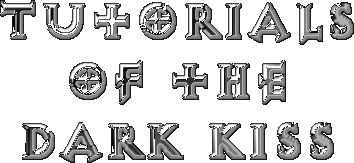
The kcf file is the palette file. It tells your cels what colors to be. All the colors available to your Kiss must be enclosed in kcf files, unless you are making a Cherry Kiss. Cherry Kiss is unpaletted, so it has acccess to millions of colors. The problem with CKiss is a) it makes file size HUGE, and b) it is still unsupported by a great many viewers. CKiss is looked upon as highly unnecessary, the only real uses for it are advanced color gradients, advanced transparency gradients, and photographic or comp gen Kiss. Many people do not bother to look at CKisses anymore, and it is a Kiss type that had a small measure of initial success, but has since fallen out of vogue. I will not be telling you how to make a CKiss in these tutorials, as I have never made one and the tools to make them are few and far between.
The other Kiss type I will not be recommending also has to do with palette, and this is the "enhanced palette" category. Palettes are considered "enhanced" when there are more than 256 colors. Including multiple 256 palettes creates an enhanced palette, as does icluding more than 17 16 color palettes (the maximum number of colors before it becomes enhanced is 256. 16 x16 = 256. The first color is duplicated in all 17, so you can subtract it. 256 - 16 = 240, then add the next palette of 16 colors (not subtracting the first color, because it needs 1 spot so it exists), 240 + 16 = 256). Not all viewers support enhanced palettes, just like CKiss. It also makes the Kiss highly unstable, and prone to crashing the viewer.
However, you can include a single 256 palette or 17 16 color palettes to be seen on all viewers. Kisses made with 256 color palettes are substantially larger in file size than those with 16 color palettes, even those with 17. This is because the cel gets translated into something that the viewer "paints by number." The kcf includes the information that tells the viewer with numbers are which colors, and the cels store the picture as pixel by pixel information, telling the viewer which numbered color each pixel should be colored. If the range is 1 of 16 instead of 1 of 256, the information takes up a lot less space. With multiple palettes, you tell the viewer which cels use which palette in the cnf. Only the colors in one palette can be used in each cel, if you cannot fit all the colors that need to be used together in one palette you have to repeat those colors in a new palette, or make the item two cels, each colored with a different palette.
Changing colors in a palette a cel is colored with changes the colors of the cel, because the information in the cel is not stored according to actual color, but with the corresponding colors in the kcf file.
There are also multiple embedded palettes. The Kisses that have the numbers highlighted in the Palette menu in your Kiss viewer have multiple embedded palettes. The colors of the Kiss change when you choose a different palette in the menu. In this case, each palette is actually a number of palettes in one (they all have to be the same number of palettes or the colors can get messed up). This does not count toward the number of palettes in enhanced, since only one set is shown at a time. To make a multiple embedded palette, you have to make each palette, and then combine them. There is a program to combine multiple palettes on a PC, but there is currently not a program that allows you to combine palettes on a Mac, although they can be seen in the Mac viewer.

